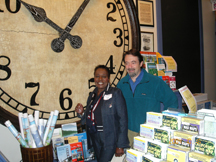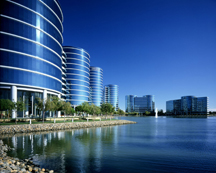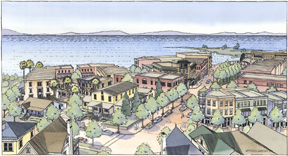
Making Cents for Ferries:
Half-cent Sales Tax Measures Add Up to $75 million
for Ferry Service to San Mateo and Contra Costa Counties
 |
| Passage of Measure
A in San Mateo County Will Make South San Francisco Home
to the Newest Ferry Route in the Bay Area (photo
courtesy Bob Ecker) |
Four counties around the Bay Area region
considered sales tax measures for transit on their November 2004
ballots, including Contra Costa, Marin, San Mateo, and Solano. These
measures, requiring a 2/3 vote for passage, passed in all but Solano
County. Successful passage of the measures in San Mateo and Contra
Costa Counties means a big victory for proponents of ferry service.
Both measures officially kick into place in 2009, when the current
sales taxes expire, and extend for 25 years. Early passage of the
measures allows counties to bond against the future revenue to get
projects started sooner.
San Mateo County: The Region’s First New Ferry Line
Measure A, San Mateo County’s half-cent sales tax measure, is
expected to raise $1.5 billion to fund transportation projects
within the county. The measure passed by a whopping 75%, far
exceeding the 2/3 support required for reauthorization. The San
Mateo County sales tax measure was first enacted in 1988 with 62% of
the vote–back when a majority was sufficient to pass a sales tax
measure.
 |
| Richmond Mayor Irma
Anderson (l) and Contra Costa County Supervisor John
Gioia: Counting the hours until Richmond has Ferry
Service |
“The passage of Measure A ensures San Mateo County
can continue to address mobility issues throughout the county,” said
Steve Castleberry, CEO of the San Francisco Bay Area Water Transit
Authority (WTA). “Along with the funding we’ve already secured, this
final amount will allow us to connect South San Francisco directly
to the East Bay via ferry service. We look forward to working with
the San Mateo County Transportation Authority in determining the
best way to use the money to deliver this service.” Measure A
allocated $30 million for San Mateo ferry service over the measure’s
25-year life span.
Castleberry explained that the financial plan for
the WTA’s newest ferry service, running between South San Francisco
and a location in the East Bay, comprises a variety of funding
 |
| Oracle employees
look forward to San Mateo County Ferry Service reaching
Redwood City |
sources. Regional Measure 2 (RM2), the $1 bridge
toll increase for regional transportation projects, funds the lion’s
share of SSF’s new ferry service. Specifically, RM2 will contribute
$12 million to buy two new vessels, and $3 million in annual
operating costs for a total of almost $226 million. Additional
funding identified for SSF ferry service includes federal dollars,
such as the $1 million for vessel construction secured by U.S.
Congressman Tom Lantos (D-CA); transit impact fees; and, of course,
fare box revenue. Rep. Lantos is seeking $6 million for construction
of the South San Francisco terminal.
Peninsula resident Jim Bigelow, who is also a
member of the Water Transit Advocates for San Mateo County and a
longtime
.jpg) |
| South San Francisco
ferry service will deliver employees who live in the
East Bay to SSF employers aong the Shoreline (photo
courtesy Bob Ecker) |
advocate for transportation improvements, said
that the Measure A victory could be attributed to an extensive
process in educating the public and building coalitions. “It’s been
very tiring the last two years. But everything worked well. I’m very
pleased,” he said.
Passage of Measure J Brings Contra Costa County One Step Closer to
Ferry Service
Contra Costa County Supervisor John Gioia, who championed Measure
J’s inclusion of $45 million for ferries as part of Contra Costa
County’s transportation improvement efforts, said, “As Contra Costa
grows, its residents want to preserve their quality of life by
having transportation options that allow them to leave
 |
| Hercules’
Waterfront Smart Growth Plans Included Adding
Alternative Transit Options Such as Ferries and Amtrak |
their cars at home but still easily reach other
parts of the Bay Area. We’ve prioritized ferries because of
development happening along shorelines such as Richmond’s. With the
technical support of the WTA, we expect to make water transit a
success story for Contra Costa County.”
Contra Costa’s successfully passed sales tax
measure, Measure J, is expected to raise $2 billion over 25 years
for transportation projects throughout the county. Like San Mateo
County, Contra Costa’s measure handily won approval from more than
2/3 of voters, with 70% support. Richmond and Hercules ferry
services are expected to benefit from the set-aside for ferries.
Additionally, Richmond received $1 million for planning from
Regional Measure 2; the WTA hopes to bridge the funding gap for
Contra Costa using Federal Ferryboat Discretionary Funds, transit
impact fees, and farebox revenues.
 |
| Richmond’s
Residential Shoreline Development Makes it Ideally
Suited to Ferry Service |
Assuming funding, environmental and other
regulatory clearance, and continued local support for the project,
Richmond ferries could launch as early as 2009, with Hercules in hot
pursuit.